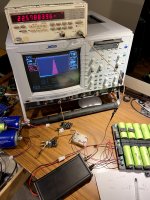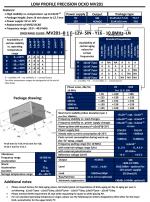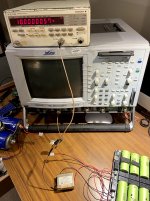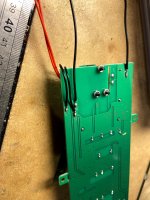Not surprised. Had a Mojo on loan here for a few days. Wasn't impressed.
It has its fans. I am happy with it given the price and portability.
What do you like better at that price point?
Around that price range I liked Topping D90. Unfortunately at this time there are no more AK4499 chips to make more D90 dacs.
Mark, my initial response was "huh" then I found this story. Holy cow.
Too bad. IIRC, you have done some DIY projects with that chip as well?
I should add to my earlier impressions that I also noted a positive difference comparing my FifoPi Q2 stack to other sources playing through the same DIY AD1865 dac, including a well-powered Pi2AES.
Last edited:
"IIRC, you have done some DIY projects with that chip as well?"
I did spend quite a bit of time working with it, yes. Possible to get exceptional SQ out of it, although IMHO no commercial AK4499 dacs fully showed what the chip was capable of.
Also liked the AK4137 ASRC and DSD converter, as did some other people. Nobody has found a complete replacement for it so far. May take a few years for that to happen.
I did spend quite a bit of time working with it, yes. Possible to get exceptional SQ out of it, although IMHO no commercial AK4499 dacs fully showed what the chip was capable of.
Also liked the AK4137 ASRC and DSD converter, as did some other people. Nobody has found a complete replacement for it so far. May take a few years for that to happen.
Hello i have rpi4b with Fifo Pi reclocer witch very good
Muzgs clocks. Im powering Pi by LPS and i have IEN ultracapacitor set for rpi. Of corse im using i2s. Im wondering about Rpi4 clocks, i know that signal is recloced by fio reclocer but take off look this https://m.pl.aliexpress.com/item/10...crddsacauige17b6c904cb925ca5a8a1d6a086&gclid=
Mayby adding better clocks to rpi will do something good in sound. Very thanks for opinion.
Muzgs clocks. Im powering Pi by LPS and i have IEN ultracapacitor set for rpi. Of corse im using i2s. Im wondering about Rpi4 clocks, i know that signal is recloced by fio reclocer but take off look this https://m.pl.aliexpress.com/item/10...crddsacauige17b6c904cb925ca5a8a1d6a086&gclid=
Mayby adding better clocks to rpi will do something good in sound. Very thanks for opinion.
No lock on FiFoPi Q3
Finally found some time to finish my first build:
ReceiverPi -> FiFoPi Q3 -> TransportPi
Goal of the project is to build a reclocker for my cd-transport (Moon 260D).
When I connect my cd-transport and start up the system everything looks fine. The green leds for lock and I2S on the FiFoPi are on as well as the blue led of the ReceiverPi (S/PDIF input enabled). But as soon as I start to play a cd both green leds on the FiFoPi are flashing as well as a green led on the ReceiverPi (RPI input). There is no audio output at TransportPi.
I’ve tested the system with another cd-player and everything works fine.
Does anyone knows what is causing this problem?
Thanks in advance!
Finally found some time to finish my first build:
ReceiverPi -> FiFoPi Q3 -> TransportPi
Goal of the project is to build a reclocker for my cd-transport (Moon 260D).
When I connect my cd-transport and start up the system everything looks fine. The green leds for lock and I2S on the FiFoPi are on as well as the blue led of the ReceiverPi (S/PDIF input enabled). But as soon as I start to play a cd both green leds on the FiFoPi are flashing as well as a green led on the ReceiverPi (RPI input). There is no audio output at TransportPi.
I’ve tested the system with another cd-player and everything works fine.
Does anyone knows what is causing this problem?
Thanks in advance!
Just an opinion... changing the clock in the Rpi, or any other computer in the chain should make zero difference in the sound. The timing of the signal depends only on the clock in FIFOPi. Think about it. The data is buffered and delayed in many places from the recording studio to FIFO. There are many computers in the network. It sits on a CD or HDD for long periods and for small periods on network devices. Any delay or buffering is inconsequential. That is the whole purpose of FIFOPi. Unless there were a buffer under/over run, the playback timing is determined by the clock in the FIFO.Mayby adding better clocks to rpi will do something good in sound. Very thanks for opinion.
If there is no FIFOPi, then the clock in Rpi would determine the sound and it would be very bad.
D
Deleted member 537459
do you speak because you have tried, or because you think it is so ...
from my experience of the last 3 years, i have found improvements on both rpi clock change, ethernet switch clock and roon core source clock.
in fact I prefer rpi 4 which has a dedicated chip with its 25mhz oscillator. the previous ones have an ethernet via usb and it sounds worse to me.
seeing is believing.
from my experience of the last 3 years, i have found improvements on both rpi clock change, ethernet switch clock and roon core source clock.
in fact I prefer rpi 4 which has a dedicated chip with its 25mhz oscillator. the previous ones have an ethernet via usb and it sounds worse to me.
seeing is believing.
Ethernet switch clock........FFS
You obviously know little to nothing about networking and its relationship to clocks and clocking. You should try filling your router/switch/modem with sand and then listen to the result, you'll have a big surprise.
Last edited:
Agreed. As I said, just an opinion. Generally isolators have not been perfect.That is assuming an ideal FIFO however.
You obviously know little to nothing about networking and its relationship to clocks and clocking. You should try filling your router/switch/modem with sand and then listen to the result, you'll have a big surprise.
or you could just assume that i have a decent dac with a working buffer that renders jitter way way beyond audibility.
syn08's sarcasm (more facetiousness) sq225917. he was Joking.
he must be real fun at parties
Trying to get the most out of TWTMC clocks for FifoPi (11)
DRIXO 22.5792MHz frequency stability test with/without an oven
A.Testing conditions
YOKOGAWA TC110 precision frequency counter warm up one hour before test
Gate time: 10s
Frequency resolution: 0.1Hz @ 100Mhz range
Morion MV201 precision 10MHz OCXO as calibration reference
13.2V LifePO4 power supply as DRIXO power
DUT: DRIXO with 22.5792MHz Laptech 3rd over ton SC-CUT crystal
B. Testing process
DUT started at room temperature without an oven
0 minutes: 22.5783892MHz
30 minutes: 22.5784683MHz
60 minutes: 22.5784740MHz
90 minutes: 22.5784757MHz
After 120 minutes
Stay between 22.5784771MHz to 22.5784778MHz
Frequency changed less than 0.3Hz for every 10 seconds
But very sensitive to environment temperature
When the AC of my house started (temperature changed less than 0.3°C), the frequency can drop to 22.5784766MHz
Then apply dual 80°C oven heating elements, after next 60 minutes
Stay between 22.5788402MHz to 22.5788407MHz
Frequency changed less than 0.1Hz for every 10 seconds
Doesn’t sensitive to AC start and stop or the ambient temperature
C: Calibration
DUT is the Morion MV201 precision 10MHz OCXO
After 10 minutes of start
Stay at exactly 10.0000057MHz
After another 30 minutes
Increased only 0.1Hz to 10.0000058MHz
Really stable
D: Conclusions
1. DRIXO needs at least a couple of hours to reach a stable frequency at room temperature after start. But still very sensitive to the changing of the ambient temperature. Change in 0.3°C can make the frequency immediately shift more than 1Hz.
2. With a dual 80°C oven installed, the frequency becomes more stable and doesn’t sensitive that much to the room temperature. The relationship between long term frequency stability and the short term phase noise is still not very clear, however, with the ovens attached to the SC-CUT crystal, the changes to the sound quality are pretty positive. And I believe the more than 1Hz frequency shift should be shown on the phase noise plot if that change is within the measurement time.
3. The Frequency Tolerance of DUT was measured -32ppm/-15ppm without/with an oven.The Frequency tolerance of the reference commercial OCXO was measured only 0.57ppm under the same testing condition.
Some notes about the oven installation
Ovens may introduce EMI noise into the DRIXO if the circuits are floating. One terminal of each PTC heating element must be connected to the PCB ground to avoid degrading to the low jitter performance.
And I’m still not sure if the aluminum case needs to be connected to the PCB ground.
Other links:
1.https://www.diyaudio.com/forums/dig...mate-weapon-fight-jitter-657.html#post6668751
2.https://www.diyaudio.com/forums/dig...mate-weapon-fight-jitter-660.html#post6671042
3.https://www.diyaudio.com/forums/dig...mate-weapon-fight-jitter-662.html#post6675622
4.https://www.diyaudio.com/forums/dig...mate-weapon-fight-jitter-664.html#post6678025
5.https://www.diyaudio.com/forums/dig...mate-weapon-fight-jitter-673.html#post6686256
6.https://www.diyaudio.com/forums/dig...mate-weapon-fight-jitter-677.html#post6690153
7.https://www.diyaudio.com/forums/dig...mate-weapon-fight-jitter-682.html#post6704886
8.https://www.diyaudio.com/forums/dig...mate-weapon-fight-jitter-687.html#post6718041
9.https://www.diyaudio.com/forums/dig...mate-weapon-fight-jitter-694.html#post6741950
10.https://www.diyaudio.com/forums/dig...mate-weapon-fight-jitter-710.html#post6756214
DRIXO 22.5792MHz frequency stability test with/without an oven
A.Testing conditions
YOKOGAWA TC110 precision frequency counter warm up one hour before test
Gate time: 10s
Frequency resolution: 0.1Hz @ 100Mhz range
Morion MV201 precision 10MHz OCXO as calibration reference
13.2V LifePO4 power supply as DRIXO power
DUT: DRIXO with 22.5792MHz Laptech 3rd over ton SC-CUT crystal
B. Testing process
DUT started at room temperature without an oven
0 minutes: 22.5783892MHz
30 minutes: 22.5784683MHz
60 minutes: 22.5784740MHz
90 minutes: 22.5784757MHz
After 120 minutes
Stay between 22.5784771MHz to 22.5784778MHz
Frequency changed less than 0.3Hz for every 10 seconds
But very sensitive to environment temperature
When the AC of my house started (temperature changed less than 0.3°C), the frequency can drop to 22.5784766MHz
Then apply dual 80°C oven heating elements, after next 60 minutes
Stay between 22.5788402MHz to 22.5788407MHz
Frequency changed less than 0.1Hz for every 10 seconds
Doesn’t sensitive to AC start and stop or the ambient temperature
C: Calibration
DUT is the Morion MV201 precision 10MHz OCXO
After 10 minutes of start
Stay at exactly 10.0000057MHz
After another 30 minutes
Increased only 0.1Hz to 10.0000058MHz
Really stable
D: Conclusions
1. DRIXO needs at least a couple of hours to reach a stable frequency at room temperature after start. But still very sensitive to the changing of the ambient temperature. Change in 0.3°C can make the frequency immediately shift more than 1Hz.
2. With a dual 80°C oven installed, the frequency becomes more stable and doesn’t sensitive that much to the room temperature. The relationship between long term frequency stability and the short term phase noise is still not very clear, however, with the ovens attached to the SC-CUT crystal, the changes to the sound quality are pretty positive. And I believe the more than 1Hz frequency shift should be shown on the phase noise plot if that change is within the measurement time.
3. The Frequency Tolerance of DUT was measured -32ppm/-15ppm without/with an oven.The Frequency tolerance of the reference commercial OCXO was measured only 0.57ppm under the same testing condition.
Some notes about the oven installation
Ovens may introduce EMI noise into the DRIXO if the circuits are floating. One terminal of each PTC heating element must be connected to the PCB ground to avoid degrading to the low jitter performance.
And I’m still not sure if the aluminum case needs to be connected to the PCB ground.
Other links:
1.https://www.diyaudio.com/forums/dig...mate-weapon-fight-jitter-657.html#post6668751
2.https://www.diyaudio.com/forums/dig...mate-weapon-fight-jitter-660.html#post6671042
3.https://www.diyaudio.com/forums/dig...mate-weapon-fight-jitter-662.html#post6675622
4.https://www.diyaudio.com/forums/dig...mate-weapon-fight-jitter-664.html#post6678025
5.https://www.diyaudio.com/forums/dig...mate-weapon-fight-jitter-673.html#post6686256
6.https://www.diyaudio.com/forums/dig...mate-weapon-fight-jitter-677.html#post6690153
7.https://www.diyaudio.com/forums/dig...mate-weapon-fight-jitter-682.html#post6704886
8.https://www.diyaudio.com/forums/dig...mate-weapon-fight-jitter-687.html#post6718041
9.https://www.diyaudio.com/forums/dig...mate-weapon-fight-jitter-694.html#post6741950
10.https://www.diyaudio.com/forums/dig...mate-weapon-fight-jitter-710.html#post6756214
Attachments
Are you using the layer of polyester wool over the crystal as shown in the manual?
I wonder what's the limit of improvement from just using a better/thicker thermal insulator. The aluminium is not helping in this regard, I would guess exterior insulation or container would help too.
I wonder what's the limit of improvement from just using a better/thicker thermal insulator. The aluminium is not helping in this regard, I would guess exterior insulation or container would help too.
Last edited:
- Home
- Source & Line
- Digital Line Level
- Asynchronous I2S FIFO project, an ultimate weapon to fight the jitter



